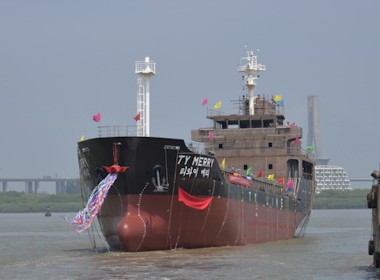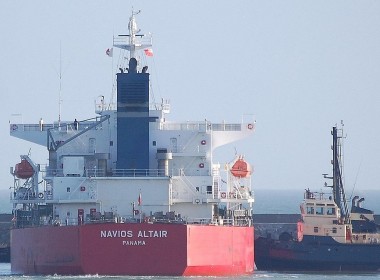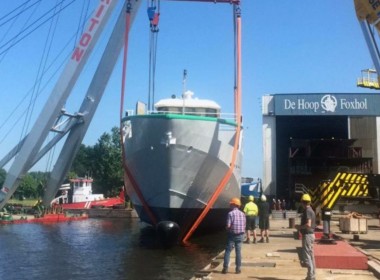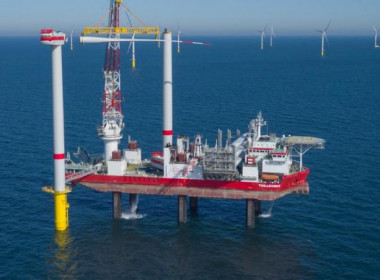VESSEL REVIEW | Grain de Sail II – French cargo sailing ship built for trans-Atlantic crossings

Grain de Sail has expanded its fleet of sailing cargo ships with the recent acquisition of a new vessel delivered by local shipyard Piriou.
Grain de Sail II was built at Piriou’s Vietnam facilities to a design by French naval architecture firm L20Naval.
“It is a pure schooner-type sailing vessel capable of carrying up to 350 tonnes of palletised freight but with a gross tonnage under 500 and a crew of six to nine people,” Grain de Sail told Baird Maritime. “We also wanted a ship with its own cranes and a dual helm station, with one in the rear behind the mainmast used for general navigation and one right behind the foremast for manoeuvring, as it would provide a better view of the operations and is an optimal position for communication with deckhands.”

The large total sail area means Grain de Sail II will be efficient even in light wind conditions. Cabins will accommodate a maximum of nine crewmembers.
The newbuild has an LOA of 52 metres (170 feet), a beam of 10.7 metres (32 feet), a maximum draught of six metres (17 feet), and two carbon fibre masts supporting sails with a total area of 1,500 square metres (16,000 square feet). Freight will be kept in separate holds split between two decks. The upper deck has space for 24 barrels for storing liquid cargo as an alternative to liquid bulk tanks.
Aluminium was selected for the vessel’s construction for being lightweight, durable, and recyclable. The 52-metre hull length meanwhile allows the vessel to access even secondary ports and marinas, thereby avoiding congested waters.

The rigging was developed using proven technologies and industry practices in construction and maintenance, resulting in a sail-to-displacement ratio of 2.5 square metres (27 square feet) of sail per tonne. This ratio means the ship can reach speeds of up to 12 knots while making it possible to reduce carbon emissions by more than 90 per cent compared to a conventional ship on an equivalent journey.
The main goal of navigating without engine assistance is to reduce environmental impact as well as engine noise.. A series of trials undertaken in different weather conditions and with different sail plan configurations confirmed that the ship’s hull, coupled with its schooner rigging, is more efficient than expected in speed with optimum balance under sail.

The vessel itself is also structurally designed to withstand cyclones, ensuring safe use in the Atlantic in all seasons.
Fulfilling the owner’s need for greater carrying capacity
Grain de Sail said it wanted a larger version of its first ship, which was the first modern cargo sailing ship to meet international maritime shipping standards. Feedback from navigating with the 24-metre vessel with a 50-tonne payload capacity was collected and then used to improve upon the design of the newer vessel and increase the dimensions.

“We are interested in reducing the carbon footprint of maritime cargo shipping and that is why we have designed pure sailing cargo ships. In addition, though, we take into account the hotel load of the ship and find ways to reduce energy consumption on board and to incorporate renewable energy sources and low carbon solutions.”
Grain de Sail remarked that one of the first steps is to “over insulate” the ship to reduce temperature variations and the need for heating or cooling. There are also closed systems for recirculation including thermodynamic double-flow ventilation
“We estimate cruising speeds of around 11 to 12 knots so we’ll be producing likely between 30 and 40 kW (40 and 53 hp). We also have electric battery packs to store energy and for use if required. For air and water heating, we have also included the first pellet broiler to be installed on a commercial merchant ship, offering a low carbon solution.”

“She is able to cross the Atlantic in about two weeks from France to the US East Coast using only wind,” added Loys LeClerq, naval architect at L20Naval. “The hotel load is shouldered by solar panels and hydrogenerators that are especially designed for the vessel. Power output is 10 kW at nine knots and 20 kW at 12 knots.
A 480kW (650hp) diesel engine will be used for in-port manoeuvring along with a front thruster for improved handling. However, when the ship is fully loaded, its displacement can reach up to 600 tonnes, making the diesel engine less viable for propulsion on the high seas.
“We only carry fuel that is good for up to two or three days of navigation for safety reasons,” said Grain de Sail. “Over long distances, we navigate using the wind or not at all.”
Viable modern-day solution for long distances
“To achieve the pure sailing cargo requirement,” LeClerq added, “we needed to optimise everything without using expensive solutions. Everything needs to be optimised and simplified.”
LeClerq remarked that Grain de Sail II is L20Naval’s first sailing vessel project, and the resulting design work provided a learning experience for the company.
“From the time we established the company, our goal has always been to reduce the environmental impact of maritime activities. We learned that sails are the most effective solution in this respect, and since then, we have been working almost exclusively on passenger and cargo sailing ships.”

Grain de Sail II will ply the trans-Atlantic route from its homeport of St Malo to the United States to transport wines and other products. For each return trip, the vessel will sail from Latin America to France with cargo consisting of raw ingredients that will be processed at Grain de Sail’s facilities in Morlaix. Crossing of the Atlantic, depending on routing choices and wind conditions, is estimated to take around two weeks, and the company expects to make up to four round trips per year.
“We are unique in that we are completely integrated,” Grain de Sail told Baird Maritime. “We are a shipowning company with a maritime business but we are also a land-based business with our own manufacturing plants for the production of chocolate and coffee, which is then sold and distributed by us under the Grain de Sail brand.”

Grain de Sail’s fleet of cargo yachts is designed to transport and supply its own raw ingredients such as cocoa and raw coffee from Latin America. The owner’s first ship, a demonstrator and prototype intentionally designed to be small, was regarded as not being fully capable of meeting production needs. The newer ship was therefore designed and built to ensure that the company can transport 100 per cent of its raw material ingredients.
With Grain de Sail II in operation, its predecessor vessel will be repurposed for coastal shipments within Europe.

| Grain de Sail II | |
| SPECIFICATIONS | |
| Type of vessel: | Cargo sailing ship |
| Flag: | France |
| Owner: | Grain de Sail, France |
| Designer: | L20Naval, France |
| Builder: | Piriou Vietnam |
| Hull construction material: | Aluminium |
| Superstructure construction material: | Aluminium |
| Length overall: | 52 metres (170 feet) |
| Beam: | 10.7 metres (32 feet) |
| Draught: | 6.0 metres (17 feet) |
| Displacement: | 600 tonnes (590 tons) |
| Gross tonnage: | 500 |
| Capacity: | 350 tonnes (344 tons) |
| Main engine: | 484 kW (650 hp) |
| Propulsion: | 2 x Lorima sails |
| Generators: | 2 |
| Cruising speed: | 12 knots |
| Other equipment installed: | PV panels |
| Type of fuel: | Diesel |
| Accommodation: | Cabins; galley |
| Crew: | 9 |
| Operational area: | Atlantic Ocean |







